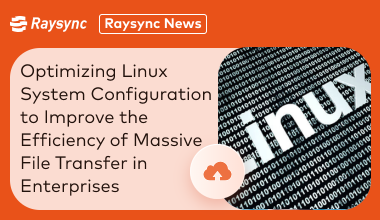Filter News

Raysync News
February 21, 2024Raysync Cloud: A High-Speed File Transfer Cloud Service
High-speed file transfer cloud service - Raysync Cloud is newly launched!

Raysync News
April 12, 2024How does Raysync enable online decompression of multiple compressed file types?
Many compressed files are transferred to a file server. Users are unable to view or preview them. The ability to unzip files online on the server solves this problem and significantly improves the customer experience in a variety of ways.

Raysync News
April 11, 2024How can organizations solve problems when sending and receiving documents on the intranet and extranet?
There are many problems with file transfers on the intranet and extranet. In this paper, we will propose the corresponding solutions for some of the frequently occurring problems and finally compare the traditional solutions to give the optimal way.

Raysync News
April 10, 2024How Does Raysync Elevate Managed File Transfer Security and Efficiency?
Managing file transfers securely and efficiently has become a top priority for organizations worldwide. This article will delve into the world of Managed File Transfer (MFT) tools and explore how Raysync stands out in this space.

Raysync News
April 10, 2024What Are the Top Alternative Solutions to IBM Aspera in 2024?
As the digital landscape continues to evolve, the search for versatile, cost-effective, and innovative Aspera alternative solutions becomes even more important. What are the alternative solutions to IBM Aspera.

Raysync News
April 9, 2024What is the Best Solution for Secure File Transfer 2024?
The data transfer process is a crucial stage for ensuring data security. This article will delve into what secure file transfer entails and specifically focus on leading solutions.

Raysync News
April 9, 2024What is the Best Way to DCP Video Transfer? 2024
This article will explore what DCP file transfer is and delve into the differences encountered when using various large file transfer tools for DCP video transcription.

Raysync News
April 8, 2024【2024】What is the best photo cloud storage tool?
In the digital age, the importance of securely managing and storing photo files is especially important. This article will explore the best tools for securely uploading image files to cloud storage to ensure that professional assets are properly protected.

Raysync News
April 7, 2024How to Improve the Efficiency of Massive File Transfer by Optimizing Linux System Configuration
In today's data-driven business environment, Linux system serves as the operating system of choice for many enterprise servers. So how to improve the efficiency of massive file transfer by optimizing the Linux system configuration?

Raysync News
April 4, 2024Best Application Tools for Cloud-to-cloud Transfer in 2024
What is cloud-to-cloud delivery technology and why is it becoming increasingly important to businesses and individuals? In this article, we will explore the nature of cloud-to-cloud transport and cloud-to-cloud transport solutions.

